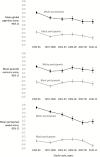Secular Trends in Cognitive Performance in Older Black and White U.S. Adults, 1993-2012: Findings From the Chicago Health and Aging Project
- PMID: 29669103
- PMCID: PMC6019012
- DOI: 10.1093/geronb/gbx167
Secular Trends in Cognitive Performance in Older Black and White U.S. Adults, 1993-2012: Findings From the Chicago Health and Aging Project
Abstract
Objective: To characterize secular trends from 1993 to 2012 in cognitive performance using a cohort of older black and white U.S. adults, and compare trends by race.
Method: Our data come from 8,906 participants of the Chicago Health and Aging Project (CHAP), a longitudinal, population-based cohort (age ≥ 67, 60% black). Participants underwent cognitive assessments in six 3-year study cycles from 1993 to 1996 through 2010 to 2012. We computed 3 measures of cognitive performance: global cognition, episodic memory, and perceptual speed.
Results: Mean performance in terms of global cognitive score followed a secular pattern of modest decline over the 6 study cycles. The trend was most pronounced for perceptual speed. Mean scores among black participants were consistently lower than those for whites; these disparities in mean performance narrowed over time, especially on perceptual speed, but appeared to widen at the last cycle. Global scores among the upper quartile of performers rose slightly, but scores among the lowest quartile of performers dropped precipitously.
Discussion: Between 1993 and 2012, secular trends in cognitive performance in this established cohort did not follow a clear pattern of improvement, contrasting with previous research. But patterns differed by cognitive domain, performance level, and race.
Figures




References
-
- Albert M., Smith L. A., Scherr P. A., Taylor J. O., Evans D. A., & Funkenstein H. H (1991). Use of brief cognitive tests to identify individuals in the community with clinically diagnosed Alzheimer’s disease. The International Journal of Neuroscience, 57, 167–178. - PubMed
-
- Baxendale S. (2010). The Flynn effect and memory function. Journal of Clinical and Experimental Neuropsychology, 32, 699–703. doi:10.1080/13803390903493515 - PubMed
-
- Bienias J. L., Beckett L. A., Bennett D. A., Wilson R. S., & Evans D. A (2003). Design of the Chicago Health and Aging Project (CHAP). Journal of Alzheimer’s Disease, 5, 349–355. - PubMed
-
- Bienias J. L., Kott P. S., Beck T. L., & Evans D. A (2005). Incorporating multiple observations into logistic regression models of incident disease. Proceedings of the Annual Meeting of the American Statistical Association—Section on Survey Research Methods [CD-ROM], 2767–2774.
-
- Bienias J. L., Kott P. S., & Evans D. A (2003). Application of the delete-a-group jackknife variance estimator to analyses of data from a complex longitudinal survey. Proceedings of the Annual Meeting of the American Statistical Association—Section on Survey Research Methods [CD-ROM], 539–544.
Publication types
MeSH terms
Grants and funding
LinkOut - more resources
Full Text Sources
Other Literature Sources
Medical

